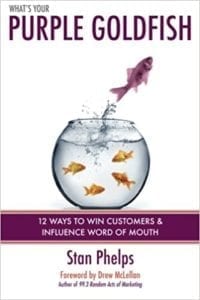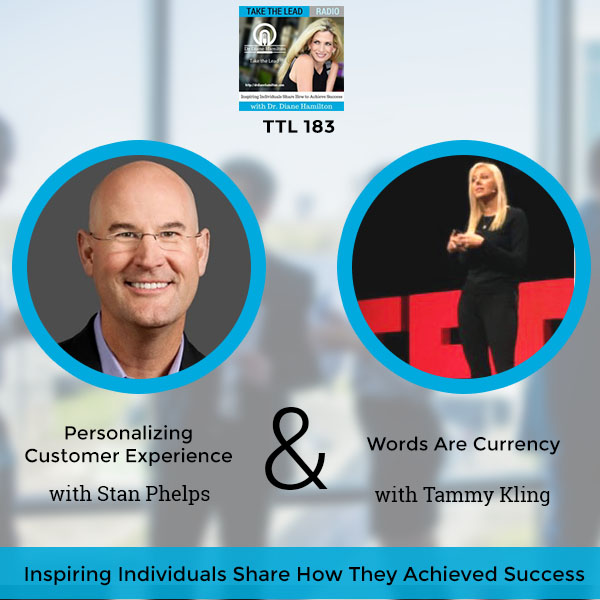There is an idea that you can become important and memorable in the minds of your customer just by using the power of words. Stan Phelps invested in this idea and applied it to marketing, knowing that when a business is doing something extra for the customer, word of mouth spreads about that unique service or product. He explains that 20% of customers drive 80% of profitability which he calls the Law of The Vital Few and the Trivial Many. Everyone needs a positive message when their day suddenly turns south. This is why words are a vital currency in this age. We write stories to learn, and from this learning we can change the world. Tammy Kling uses this belief saying that it doesn’t matter if you are a millionaire or a homeless person, you can save and change lives just by saying a good word to a person.

Our guests are TEDx speakers and very well-known. Stan Phelps is the Founder of PurpleGoldFish.com. You’ve probably seen all of his different goldfish books starting with Purple Goldfish, but he’s got another one, Pink Goldfish. Tammy Kling has helped all kinds of companies and individuals with the power of words. She’s the CEO of OnFire Books.
Listen to the podcast here
Personalizing Customer Experience with Stan Phelps

What’s Your Purple Goldfish?: How to Win Customers and Influence Word of Mouth
I am here with Stan Phelps, who’s the Founder of PurpleGoldFish.com. He’s a TEDx speaker, a Forbes contributor, and IBM Futurist who focuses on customer experience and employee engagement. Throughout his career, Stan held many marketing leadership roles with Adidas, International Management Group, PGA of America, and Synergy. He’s the author of six books: Purple Goldfish, Green Goldfish, Golden Goldfish, Blue Goldfish, Purple Goldfish Service Edition, and Red Goldfish. They all focus on the little ways to drive differentiation, increase loyalty, and promote positive word of mouth. He’s spoken at more than 200 events in eleven countries. Welcome, Stan.
Thank you for having me, Diane.
I was watching your TED Talk that you’ve done and I laughed when you talked about how Jeff Hayzlett was interested in the cookies. You were explaining why you picked purple fish originally. Do you want to tell that story?
Purple is an ode to New Orleans, specifically Mardi Gras. Purple is one of the three official colors of Mardi Gras: purple, green and gold. There is a concept that comes out of New Orleans, a word that exemplifies the idea of going beyond just the transaction to do a little bit more to honor the relationship and the word is all the way back in the 1800s by Mark Twain. He wrote about this word. He said it is worth traveling all the way to New Orleans to get a lagniappe. It’s Creole, meaning it’s French and Spanish, that literally means “The gift or to give more.” It’s the idea that when you’re doing business with someone, the business does a little something extra, and that brings us back to Jeff. If you’ve ever stayed at a DoubleTree Hotel, when you check-in to the hotel, they give you a chocolate chip cookie. It’s not an ordinary chocolate chip cookie. They keep them warm, they’re individually wrapped, they’re packed with chocolate chips, and they’re amazing.
DoubleTree gave away their 300 millionth chocolate chip cookie. They’ve been doing it all the way back since the 1980s. When I talked to Jeff about it, he says, “I love those cookies so much.” He says he dreams about those cookies when he stays at other hotels. They’re literally that good. Whether it’s a cookie or it could be any other signature thing that you do, but it’s the idea of doing something that makes you stand out and more importantly become memorable in the mind of your customer. If you can be memorable, that person is going to want to talk about that experience. That’s where referral and word of mouth marketing comes in.
You started with the Purple Goldfish and then you’ve got all these other colors that we mentioned. How did you come up with the other colors and what’s your latest color?
It was a progression. I had spent over two decades as a marketer and I got a little jaded with where marketing was going because most marketing was about trying to interrupt the prospect, get their attention, and not enough marketing in my mind was being paid towards the customers that we already have. The greatest form of marketing is how to create an experience with your customer that’s memorable, talkable and sticky. That was Purple. I crowd sourced over a thousand examples, but the revelation for me that led to the second book was the idea that many of these companies that I studied not only got it for the customer, but they even got it more so for their own employees. The Green Goldfish, which was the second book, another color of Mardi Gras, was about the little things that you do for your employees to drive their engagement as well as reinforce the culture within your organization. That led to the Golden Goldfish, which is a little bit of the customer and a little bit of the employee that was based on what do you do for your top 20%. For most businesses, the top 20% of customers drive 80% of profitability.
The Pareto Principle goes in a lot of different ways.
[Tweet “If you can be memorable, that person is going to want to talk about that experience.”]The guy who coined 80/20, he has a law. An American by the name of Joseph Juran had taken the studies that Vilfredo Pareto did, the Pareto Principle, but the law is so much more impactful than 80/20. Juran called it the Law of the Vital Few and the Trivial Many. That was Gold that led to Blue. I did a little bit of work with IBM as a futurist and I started to see the impact going forward of how important leveraging technology, data, and analytics would be. Blue was not a reference to big blue IBM; it was a reference to a Danish King in the 10th century and his nickname was Bluetooth. Back in the ‘90s when Erickson, Sony, and IBM created the wireless networking standard for personal area, they needed a code name. It just so happened this Danish king had converted the Danes to Christianity. He had united all of Scandinavia and he became the code name for the project with the engineers. They thought marketing was going to come up with a much better name, but they never did, and it stuck.
It’s the idea of how to create convergence, and Blue is about how you personalize the experience using what you know about your customer, how you become more responsive to their needs, and ideally how you get to a state of readiness to know what they want next to better serve them. That was Blue, which was followed by Red. Red I owe to U2’s Bono. Back in 2006, he created the RED Campaign. You buy certain products that are red and a portion of that goes back to charity. In Bono’s case, it’s all about Africa. I love that as a way that for-profit businesses can do something to leverage purpose because purpose is on its way to become the ultimate differentiator in business. That was all about how you leverage purpose. As we go forward, we will not distinguish for-profit versus not-for-profit. Going forward in a few years, we’ll only look at companies and go, “That’s a for-purpose company and that’s a not-for-purpose company.” The last one is the Pink Goldfish. It’s all about differentiating yourself and how you embrace what makes you weird and how you embrace what you may see as yourself as a flaw or an imperfection. Because what makes you weak can also what makes you strong and what makes you weird holds the key to what makes you wonderful. It’s the idea of either doubling down on what makes you weird or purposely doing less of what the competition thinks is normal.
You’ve gone in so many different directions with marketing and the focus. There’s so much you can write. There’s such a focus on how to deal with differentiating yourself, so I love the weird thing. What makes you weird?
It’s how I write all my books. For the first two books, I collected over a thousand examples a piece. I’ve smartened up since then and now it has always been between 200 and 350 examples for each of the books. What makes me weird is that I like to collect stories. It dates back to when I was 22 years old. They say that wherever you are in your life when you’re 22, that is literally the most impactful time of your life. It’s going to leave the biggest impression on where you are. For most people, maybe that’s the year after they’re out of college or four or five years after they’re out of high school. Wherever they are at that age is a very impressionable time. For me I graduated, I got a Blue Card to work in England. I was living in London and it was myself and two roommates in a one-bedroom flat in Central London.

Words Are Currency: They say that wherever you are in your life when you’re 22, that is literally the most impactful time of your life.
There weren’t cell phones back then. What we noticed, when we would call home or if we were just calling friends or whatever in these iconic red British telephone booths is that there were all these little cards that people would put into the phone booth. What was interesting was they were all for escorts. This was before the days of the internet. This was a way that they would advertise. It was illegal to advertise your services as an escort. They called these little cards that they put in the phone booth, tart cards. They would have to get very creative in terms of how they put the copy to stand out. There was a lot of nuance and whatnot. One of the cards would read, “Large chest for sale” or another one would read, “French lessons” with the phone number. As a gag, I’m not even sure which one of us as roommates did it, we started to grab them and, in our kitchen, we had a blank wall, we started to tape them to the wall and collect them. Before we knew it, we had over 500 up on the wall. I blame that for my preoccupation of collecting things.
That’s a unique thing to collect and I can imagine that wall captured a lot of attention. I bet it killed you to take it down. Did you ever take it down?
I don’t remember the day specifically that we took it down, but the fun was in collecting. We could never have two of the same ones. In our six months that we were there, sometimes we would travel to different parts of London just to explore the city but also to bolster the collection.
I didn’t realize that you had spent time there with all these different books and all that speaking and things that you do. You mentioned the Red book and that made me think of Mackey’s Conscious Capitalism. Do you agree with that process that we need to realize that businesses are in it for business? We don’t think of doctors as being in it for business, but they are, and we got to change our perspective. Is that your thought process with that?
Business has evolved and we’re entering the 4.0 version of business. The 1.0, which was back to early days of corporations, there was a sole purpose of a corporation. It was to maximize the value to return to the shareholder. In the 1970s, I’m a disciple of a guy by the name of Ted Levitt who used to be the Editor of Harvard Business Review. He’s a Harvard professor. He ushered in what he would call the 2.0 version and that was about putting your customer first. The idea is you’re solely in business to create and keep a customer and then if you do that and you do that successfully, the shareholder benefits. In the ‘80s, ‘’90s and the early 2000s, we jumped into the 3.0 version where it realized the simple fact that you can’t have happy customers unless you have happy, engaged employees. It’s just never going to happen. The smart companies in the 3.0 version put employees at the center of everything that they did.
You would see a big emphasis on culture in the last ten to fifteen years. We’re on the cusp now of the 4.0 version and that is putting purpose first and it is the bulls-eye of everything we do. We’re only two years away from millennials becoming 51% of the workforce. If that doesn’t scare you, by 2025, that number is slated to increase to about 75% of the workforce. They have a much different view of business than me as an X-er and Boomers. They put a much bigger emphasis on purpose for the companies that not only that they work for, but also the companies that they purchase from and the companies going forward that can embrace purpose and do the little things to bring that purpose to life. It’s not enough for it just to hang on your wall; it’s going to be through your actions to bring it to life. They’re the ones that are going to win.
I have had people tell me that they think millennials are broken into two categories. You have ones that are totally motivated and driven to be a certain way, and then there are others that lack that drive and motivation and they’ve gone in a different way. It led to my interest in writing my book on curiosity. Do you consider that millennials are split like that? Do you see them all as an overall group? How important is curiosity?
There’s a big difference. I’m not an expert by any means, but a lot of people would say early stage millennials are much different than later stage millennials in terms of what they think and how they act. It’s unfair to lump them into one. I’m an X-er. When I took a job, it was keep your head down, do what you’re told, and maybe two or three years in, you might be able to jump up to the next level, but until then, you earned your stripes. My father who’s a Boomer spent 40 years with one company and moved twenty times. Whatever the company said, he did. As an extra, I have had two eight-year stints with companies and that’s a long time. For a millennial, they could be in their fifth job in their fifth year of being out of school and think nothing of it. It’s a little bit of a different mindset, so there’s more of a premium on how to make sure that those millennials are engaged. They’re much more conscious when they’re out purchasing. You have Boomers that are now leaving the workplace and they’re looking for purpose in what they do. I don’t think it’s fair to lump millennials to say they are the only ones that care about it.
There’s many ways to be different and every group is different. It’s hard to categorize people with neat little boxes. You talked about being different and ways to differentiate in your book. When you say ‘differentiate’, in what way?
[Tweet “The central tenet is try to figure out ways that you can do more of what makes you unique.”]A lot of it is either based on the positioning of your brand, so how to go out to the marketplace, what to put an emphasis on. It’s all the way down to what we call micro-weirding. They are little things you can do in the experience that you provide for your customers to bring some of that uniqueness to life. The central tenet is try to figure out ways that you can do more of what makes you unique. Sometimes that’s your flaws and imperfections. Don’t try to hide them. We’re much more accepting of brands that aren’t trying to cover their warts. It’s rare to see a brand that goes, “I have these warts and I’m proud of them.” They are the ones that stand out. If you don’t want to toot your horn on what makes you weird, understand that benchmarking the competition and trying to keep up with the latest edition or the latest thing, that’s no way to stand out because you’re just a ‘me too’ or an ‘also ran’. What you want to do is figure out ways that you can be less normal.
Shama Hyder shared a picture in her talk and it’s a blackboard outside of a restaurant that says, “Come in and try the worst meatball sandwich that one guy on Yelp ever had in his life.” They embraced it.
When you get a bad review, embrace it. One of the funnier ones that we featured in the book is a movie theater. It’s called the Alamo Drafthouse. The Founder, Tim League, and the whole crew are passionate about the movie-going experience so much so that they have a no-texting and no-talking policy. Zero tolerance when you’re in the theater. They are from Austin, Texas, but they’re now all over the US. In Austin, somebody was warned and then didn’t put their phone away. It’s in the rules, they were asked to leave, and they were ejected from the theater. They left. It seems like an intoxicated voicemail message wailing against the Alamo Drafthouse. Some companies would go, “We need to apologize and refund the money.” What Alamo Drafthouse did was they made it into a PSA. They play it before the movies. It got picked up by CNN and went viral.
It’s understanding what makes you weird. There’s a great Japanese art called kintsugi. It dates all the way back to the 15th century with this Japanese shogun. We all have like our favorite coffee mug. He had a tea bowl that he would use all the time. Somehow it got knocked over and broken and he was distraught. He sends it out to be repaired, and a few days later, it comes back. He’s so distraught because it was coarse glue and metal staples to hold it together and that wasn’t good enough for him. He sent this tea bowl to his craftsmen and they meticulously took it apart. They used lacquer and gold to repair it. When it came back, he was so pleased with the result and the idea that the gold illuminated the flaws not only made the tea bowl restored to its original form but added value to it. That’s a great metaphor for this idea of the Pink Goldfish. These little imperfections, if we shine a light on them, these little flaws hold the keys to what makes us awesome or what we call being flawsome.
I would love for you to share how people can find your books and contact you. Can you share some of that?
You can go to Amazon. Purple was my first one and it goes all the way down. Once you pull up one, you’ll see the others. I do keynotes and workshops. If you want to learn a little bit more about me in that background, the best site is StanPhelpsSpeaks.com or you can go to PurpleGoldfish.com.
This has been so great, Stan. Thank you so much.
Thanks for having me.
You’re welcome.
Words Are Currency with Tammy Kling
I am here with Tammy Kling, who has helped Ritz Carlton, Frito Lay, and Mary Kay Corporation with the power of words. She is a communications expert, sought-after keynote speaker, and Founder of the Words are Currency Organization and a Conversation with World Changers. Kling is the CEO of OnFire Books, the company that creates legacy books for professional athletes, celebrities, CEOs, and speakers. It’s so nice to have you here, Tammy.
Thank you. It’s an honor to be on your show.
I have had other word experts before. I had Phil M. Jones. He has a book called Exactly What to Say. I love to talk about using words and how words can build and destroy. You have a TEDx Talk and you’ve done a lot of communicating about this. Tell me about what made you interested in words?

Words Are Currency: It doesn’t matter if you’re a billionaire or a homeless person, you can change someone’s life, which makes you wealthy.
Like most people, our ultimate life-calling comes from something like a seed planted in your heart and maybe it’s not so obvious until a certain point in life. For me, the desire to change lives comes from as a child, my background. My father committed suicide when I was seven and it didn’t crystallize for me why I started my company until about a decade into writing books for leaders. I realized after sitting with CEOs and listening to them talk about the personal aspects of their lives and the depression or things that they were dealing with, I saw my father in every man. I talk about that on my TEDx Talk. I talk about how words are currency. It doesn’t matter if you’re a billionaire or a homeless person, you can change someone’s life, which makes you wealthy if you are bold enough to use your words. It doesn’t have to be talking to someone out of suicide or talking them off the cliff. You might just verbalize a positive thought that you have for a stranger and that could change the entire trajectory of his or her day. You might change someone’s heart or mindset or diffuse some anger with your words and that makes him or her go home and be a better parent, for instance.

There’s More to Life Than the Corner Office
You’ve used a lot of words with all your books. There’s More to Life Than the Corner Office is a global book that you wrote with a leading CEO. Tell me about OnFire Books.
OnFire Books is a leadership company. We started years ago. I was with Zig Ziglar and all these greats. It was Zig that caused me to start my company. It was a moment with him at his 80th birthday party that caused me to come up with the idea to equip world changers. I realized that I want to help guys like Zig who have an incredible message and I want to help guys and women world changers impact lives. When we write a book for someone at OnFire Books or if we help get someone published, edit a manuscript, or we get them on a television show like NBC or Oprah or we get them into Huffington Post. When we do that, we are going to help them impact millions of lives. It’s about helping people get a positive message out.
Your books are sold in 32 countries and they’ve been featured on Dateline NBC, Oprah Radio, Primetime, Extra, 20/20, The Discovery Channel, Geraldo, The New York Times, The Huffington Post, and The Wall Street Journal. How do you help them? Do you do ghostwriting? What exactly do you do to help them?
We have a ghostwriting division and we also have OnFire Leadership and we have a Speakers Bureau. We also own The World’s Largest Book Club and that’s a wonderful way to get the book out. We featured a book and got 10,200 views on it. If you can imagine a virtual book club where people can read the book, they can log on, they can talk about the book, and they can meet the author if they want to. All of that helps us help our authors get the message out. Another thing we do is we connect authors to our CEOs. We have a big corporate division. We did this book for a leader at Walmart. Before the book is even published, she sold $56,000 in books and that’s just from being online pre-sale. We work with our authors in advance to give them ideas on what they can do that are non-traditional, like a blog tour, connecting with tipping point people, and not just following the traditional route.
Any way that we can equip a world changer to speak, to get on fabulous shows like yours, then we know that we’re going to be able to get the word out. We also work with a lot of reporters, journalists, and producers to make sure that our authors are featured, that our books are being sent all over the world, whether it’s an orphanage or a company in Russia. I am going with my entire team to teach a writer’s workshop in an orphanage. What’s amazing about that is we get to bring our authors’ books there. You’re writing a book for instance, and that’s the purpose of writing a book. You can’t be everywhere, but if you write a book and someone takes it to a school or an organization, you don’t have to be everywhere. We focus on the power of multiplication. We also build book libraries. We’re building a book library at this particular orphanage. We’re going to stock this book library with hundreds of our client books of all kinds of leadership books and things that these kids may not ever have had access to.
Are you an actual publisher? A hybrid? Where are you in this whole spectrum of what you offer?
The only thing we don’t do is print books. We’ve chosen not to because we have several relationships with major publishers. We have sold books to Simon & Schuster and McGraw-Hill. However, we also have the ability to pick up the phone, get our clients on a call with a hybrid model publisher, and we walk the client through all of that. If somebody comes to us with a manuscript and they’re ready to go, we will consult them through the stage of publishing so that they don’t get confused. We’ll make sure they avoid any landmines because unfortunately in this business, a lot of people just go and upload a book online, but then they miss out on global distribution. If somebody uploads a book to Amazon, the issue with that is it does compete with Barnes & Noble, and the brick and mortar book stores won’t carry it. We want to make sure it’s on Walmart.com China, we want to make sure it’s on Walmart.com and we want it on Amazon and Barnes & Noble. We want to be able to have your book everywhere, so we coach them through that process. I’ve never ever had anyone in a decade come to us that didn’t have a major blind spot that was a difference maker in selling a book.
Give an example of the blindspot.
[Tweet “You want to put compelling sales copy on the inside of that book cover. It might be your only opportunity to sell.”]One blind spot would be cover copy. We had someone that was very intelligent and had a big marketing company. Because their business was marketing, I let them run with it and they insisted that they knew everything about the book. We always guide our clients through the book cover process based on information that publishers tell us. For instance, a publisher told me never do purple on a book cover and they explained why. They said purple does not sell at all except to the new age community. If you’re trying to do this type of book, like leadership, you don’t want to do purple. We use all of the data and the analytics and we also use our wisdom from publishers and we coach our clients through this. This particular person went ahead and decided to do their own book cover and insisted, “We know how to do this.” When we got the book, it’s a book that I can’t even promote. I can’t feature them on The World’s Largest Book Club. I can’t promote it because the cover is so bad. They completely forgot or just wouldn’t take advice to put a cover copy. You want to put compelling sales copy on the inside of that book cover. It’s your opportunity to sell. It might be your only opportunity to sell. They didn’t do that, and they missed out on a huge opportunity to sell their book.
You say purple is bad. I see a lot of red and white and certain colors on leadership books. What do you suggest?
I have an exercise that I always tell our authors to do. We have six weeks of coaching calls throughout the process, and on the second call, I tell them, “I want you to take a journal and I want you to go to the bookstore. I need you to find six books that you personally visually relate to and take a screenshot of the book cover with your cell phone.” I ask them to do that and often, the covers are even very diverse. One might be white, one might be multicolored, and then we start from there. We start from, “What is it that you like?” Then we talk about the consumer. If you’re selling a leadership book, it always should be very clear and simple. Blue is a big leadership color. Blue is definitely a big book for the corporate executive world, so simple white cover with blue details is what I would suggest for a leadership-type book. If it’s a personal development book or something else, then it’s all very different.
You’re making me wonder for my curiosity book what color I need because it’s for business, but it’s also self-help-ish.
If it’s a self-help book, you can be a lot more creative. The key there is to do what you love but take yourself out of it because a lot of people will have blind spots and say, “My first vision or memory of something was a teddy bear” and they’ll go into the story about a teddy bear and they want a teddy bear on their cover. That doesn’t speak to everyone. For a self-help book, you want to paint an entire vision of what your book is visually. If you’re trying to help someone, you’re going to want to have them see hope in your book.
I’m thinking some of these business books like mine would be more in line with something like a Daniel Pink’s book Drive, that type of thing where it’s leadership, it’s business, but it’s also help. It’s not necessarily self-help. His book is white and red. I’ve had other people on my show who’ve written similar books and they’re different. Your process is coaching and an agent, too, if you’re getting them publishers, so you’re a combination of things?
We coach people through the book process, but also, we work to cross-pollinate. There is a huge Global Women’s Summit and they reached out to me. I have one of our female authors that I am going to get as a guest speaker at this Global Women’s Summit. We got another author a speaking job at Times Square, her very first speaking gig after she published her book and her book is a bestseller in a lot of airports. We cross-pollinate. We also take our authors’ books and we send them out. We have a program called Litter Box and we send books out on the first of every month. It helps to get books into different industries. If somebody writes a book about dementia or anti-aging, we would send it out to the appropriate organizations and our contacts, whether it was a healthcare organization or something that helped that group of people that was the audience. If somebody wrote a book about leadership and they’re a consultant or a speaker, we would send out the book to CEOs that we know have annual conferences.
It’s interesting that there’s this whole process and you aren’t hybrid, you’re not traditional, you’re not a coach, you’re a combination of things and that’s unique. I’m curious how long this process is. I’ve had publishers tell me if I gave them a book, it would take them a year to publish it. What’s the timeframe in all of this?
A lot of times, I might take somebody to Simon & Schuster and they can get published, but a lot of times, they’ll say, “I don’t want to wait a year and a half.” The old model of publishing is a year and a half, but a lot of times, people don’t want to wait. They just want to get out there and they want to start speaking. We’ll direct them in a different direction and if somebody says, “I want to start speaking right away,” we will get the book out there right away.
Who keeps the rights? Is this a hybrid model or a self-publishing model or the author keeps the rights? What about audio rights?
Audio rights are something that you definitely should keep your rights for sure, but an audio book is something that happens after the book is published, the audio and interviewing talent.
What do you think is the biggest advantage you offer to people that maybe were going to self‑publish?
The biggest advantage is definitely helping them pick that specific publisher. We have relationships with self-publishers that would make a difference. There are self-publishers that aren’t who we recommend and then there’re publishers that have strong distribution relationships with people like Ingram, which is the largest distributor in the world.
I notice that to create space, some of the others are doing different things than they used to. Some of them aren’t doing covers and doing other things. Do you foresee a lot of those changes with those types of publishers?
There’s going to be a lot of changes in publishing. Unfortunately, the industry is like the car dealership industry. You do have to be careful. You might get somebody that sells you something that they cannot deliver. We have people coming to us all the time saying, “I gave my manuscript to this self-publisher and it’s been nine months.” We have a guy who has literally fought with these people on graphics from a self-publisher. We help people navigate the process so that they’re careful and know what they’re getting into. It’s an industry that is just so unregulated and you have to be intelligent about it, and a little bit of wisdom and a little bit of coaching goes a long way. We have clients that have done six books, but if we coach someone through one book, they might end up doing 40.

Words Are Currency: Publishing is an industry that is just so unregulated and you have to be intelligent about it.
A lot of people don’t realize, and they expect that from their first book, they’re going to get this big check from the publisher and they’re going to get all these things. It’s not like that anymore and it costs a lot of money to publish a book. What do you tell people who expect things that aren’t the reality of how it will be?
A book is an investment and it’s a whole business model. It’s an investment in yourself, but I recommend that the only people that should write a book are somebody that realizes that it’s like a product. It’s like starting a company and it truly is an investment. It’s like if you owned a Porsche dealership, you want to make sure that you’re going to be investing in marketing. It’s not that big of an investment but it is important to not think you’re going to publish something and then be famous. It takes a very strategic marketing plan.
I meet so many people who don’t realize how much goes into it. Sometimes it’s better to get a ghostwriter if you have a lot of content but you don’t have time, right?
We ghostwrite books for brilliant people. Sometimes we ghostwrite books for billionaires, but we also have ghostwritten books for single moms. We do that every year. It’s just that a single mom doesn’t have time. She may already have a great manuscript or a great idea, and if we interview her, we can get her thoughts on paper by interviewing her whereas a lot of times people have trouble getting the words out or having the time.
What’s a good length for a business book? How many words is a good length? 50,000 or 60,000?
That’s way too many. I don’t like going by the traditional model. There’s so much misinformation out there. I believe that people read and consume information on Twitter, Instagram, Facebook in short bursts and we have to be able to not only coach people to write books that way as if each chapter can stand on its own, but also much shorter books. For business books, I don’t like anything over 200 pages anymore and some New York publishers are still asking for 300, which is excessive.
We don’t want War and Peace. I’ll never read it, but you need to have a certain level of whatever the publisher is looking for and all the advice you offer is helpful. A lot of people want to know how they can find out more about you. Can you share how they can learn about you and your company?
You can feel free to Google Tammy Kling or you can email me at Tammy@OnFireBooks.com or you can watch my TEDx Talk on my website, which is TammyKling.com. Hopefully that will help any aspiring writer, but I love to help coach people through their books, whether they have a manuscript or just an idea.
Thank you so much, Tammy. This has been interesting, and I enjoyed our conversation so much.
Thank you.
Thank you so much to Stan and to Tammy. If you’ve missed any past episodes, you can find them at DrDianeHamilton.com. You can either go to the blog or the radio version of the show. It’s nice having the blog version now because you can not only listen to this show but see some of the words and links and things that we’ve discussed on the show, so it’s a combination. Please sign up on my site and it’ll notify you anytime you want to get a future episode. We’re also an iTunes, Roku, iHeart, and everywhere else. I hope you check that out.
About Stan Phelps
 Stan Phelps, is the Founder of PurpleGoldfish.com. He is a TEDx speaker, Forbes contributor and IBM Futurist who focuses on customer experience and employee engagement. Throughout his career Stan held many marketing leadership roles with Adidas, International Management Group, PGA of America and Synergy. He’s the author of six books: Purple Goldfish, Green Goldfish, Golden Goldfish, Blue Goldfish, Purple Goldfish-Service Edition and Red Goldfish. They all focus on the little ways to drive differentiation, increase loyalty, and promote positive word of mouth. He has spoken at over 200 events in 11 countries. Stan holds a JD/MBA from Villanova University and a Certificate in Achieving Breakthrough Service from Harvard Business School.
Stan Phelps, is the Founder of PurpleGoldfish.com. He is a TEDx speaker, Forbes contributor and IBM Futurist who focuses on customer experience and employee engagement. Throughout his career Stan held many marketing leadership roles with Adidas, International Management Group, PGA of America and Synergy. He’s the author of six books: Purple Goldfish, Green Goldfish, Golden Goldfish, Blue Goldfish, Purple Goldfish-Service Edition and Red Goldfish. They all focus on the little ways to drive differentiation, increase loyalty, and promote positive word of mouth. He has spoken at over 200 events in 11 countries. Stan holds a JD/MBA from Villanova University and a Certificate in Achieving Breakthrough Service from Harvard Business School.
About Tammy Kling
 Tammy Kling has helped Ritz Carlton, Frito Lay, and Mary Kay corporation with the Power of Words. She is a communications expert, sought-after keynote speaker and founder of the Words are Currency Organization and a Conversation with World changers. Kling is the CEO of OnFire Books, the company that creates legacy books for professional athletes, celebrities, CEOs and speakers.
Tammy Kling has helped Ritz Carlton, Frito Lay, and Mary Kay corporation with the Power of Words. She is a communications expert, sought-after keynote speaker and founder of the Words are Currency Organization and a Conversation with World changers. Kling is the CEO of OnFire Books, the company that creates legacy books for professional athletes, celebrities, CEOs and speakers.
Important Links:
- Stan Phelps
- PurpleGoldFish.com
- Purple Goldfish
- Pink Goldfish
- OnFire Books
- Green Goldfish
- Golden Goldfish
- Blue Goldfish
- Purple Goldfish Service Edition
- Red Goldfish
- Jeff Hayzlett
- DoubleTree Hotel
- RED Campaign
- Conscious Capitalism
- Ted Levitt
- Shama Hyder
- Alamo Drafthouse
- StanPhelpsSpeaks.com
- Tammy Kling
- Words are Currency
- Conversation with World Changers
- OnFire Books
- Exactly What to Say
- There’s More to Life Than the Corner Office
- Speakers Bureau
- The World’s Largest Book Club
- Walmart.com
- Drive
- Global Women’s Summit
- War and Peace
- Tammy@OnFireBooks.com
- TammyKling.com



0 Comments